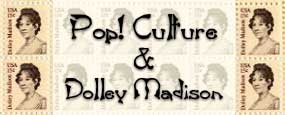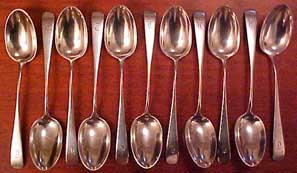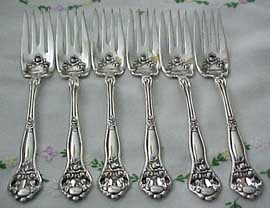

Mass produced silverware had its origins in the 1830s, and
began to take off after the expression of a wide interest
at the Centennial Exposition of 1876 in Philadelphia. It
is subsequent to that date that we find an exploding number
of patterns and companies. Very few of these patterns were
simply numbered but each had to be simply identified;
silverware companies therefore chose distinctive names for
each one of their patterns, and each name was intended to
convey to the potential buyer something about both the
nature and quality of the pattern. Silverware names range
from flowers (buttercup) and nature (firelight), to
architectural style (Corinthian), to geographic place (Atlanta)
and historic mansion (Mount Vernon), to historic figures
(Jefferson, King Edward, or Balzac).
 Several companies named patterns after Dolley Madison.
William B. Durgin founded the Durgin Company. It became a
premier name in American silver and remained so until 1905,
when William Durgin died. At that point the Gorham Company
purchased it, although it did not completely take over
production until 1923. Among its many patterns Durgin
introduced in 1904 both a Dolly Madison pattern and a Dolly
Madison engraved pattern. Several companies named patterns after Dolley Madison.
William B. Durgin founded the Durgin Company. It became a
premier name in American silver and remained so until 1905,
when William Durgin died. At that point the Gorham Company
purchased it, although it did not completely take over
production until 1923. Among its many patterns Durgin
introduced in 1904 both a Dolly Madison pattern and a Dolly
Madison engraved pattern.
 Gorham was an extremely large firm with a very high number
of patterns in its stock. The company began in the 1830s
and despite a tangled corporate history remained in
business until 1989 when it was sold to Dansk International
Design, Ltd. Gorham introduced its own Dolly Madison
pattern in 1929, separate and different from that
introduced by Durgin. Gorham was an extremely large firm with a very high number
of patterns in its stock. The company began in the 1830s
and despite a tangled corporate history remained in
business until 1989 when it was sold to Dansk International
Design, Ltd. Gorham introduced its own Dolly Madison
pattern in 1929, separate and different from that
introduced by Durgin.
 There was also Holmes and Edwards Silver Company that
specialized in silver plating. The company began in
Bridgeport, Connecticut in 1882 and was later sold to the
International Silver Company. The company also produced
small silverwares and novelties. There was also Holmes and Edwards Silver Company that
specialized in silver plating. The company began in
Bridgeport, Connecticut in 1882 and was later sold to the
International Silver Company. The company also produced
small silverwares and novelties.
Oneida introduced a Dolly Madison silver plate line in
1914. John Humphrey Noyes founded the company in 1848 at
Oneida Creek in upstate New York, but the company did not
begin manufacturing tableware until 1877 and silver plate
in 1926.
Dolan, Maryanne. American Sterling Silver Flatware. 1993.
Hagan, Tere. Silverplated Flateware. 1990.
Rainwater, Dorothy T. and Ivan H. American Silverplate. 1988.
|